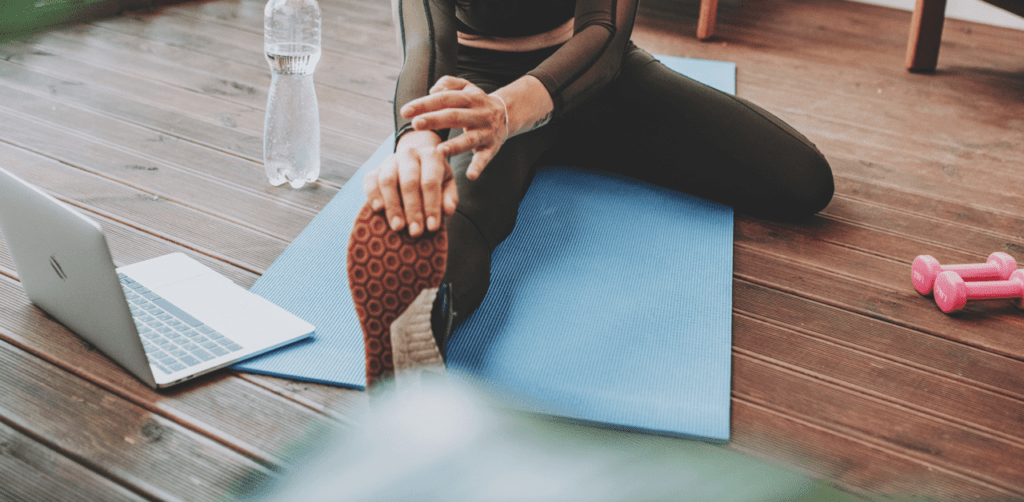We know by now that the pandemic has changed the fitness industry forever. Covid-19 has accelerated the hybrid fitness business model, combining an offering of online and in-person workouts. Fitness businesses were quick to pivot to online fitness, and it’s something that most gym owners have now embraced. According to Club Intel research, 72% of fitness club-owners now offer on-demand and livestream group workouts, up from 25% in 2019.
By successfully adapting to the sudden change in circumstances, the fitness industry has proven its resilience over the last year. Moving online back in March 2020 was initially a matter of survival, but the gyms of today aren’t just surviving – they’re thriving.
We’re all tired of hearing it by now, but running a fitness business either partly or entirely online has become the ‘new normal.’ The same goes for gym-goers; over the last year, the member experience has been mostly online.
Still, amid the successes of online fitness, there have been significant changes in the industry. Not everything will go back to how it was before Covid-19. Now, global vaccine rollouts are underway, and there is a light at the end of the tunnel for returning to ‘normal.’
So what lies ahead for the future of gyms in a post-pandemic world?
- The World’s Changed Perception of Fitness
- How Fitness Operators Must Respond
- What This Means for the Future of Gyms
The World’s Changed Perception of Fitness
Covid has changed the way people view fitness, along with their behaviors towards it. Once the world comes out on the other side of the pandemic, people’s lives will change again, this time going back to ‘normal.’ With this, some habits and behaviors will also go back to how they used to be. But some will last long past Covid.
Here we’ll look at how consumers’ perceptions of fitness have changed not just now but forever. We’ll cover how people feel about exercising and the gym, their changed view of what health and fitness means, and how technology will continue ingraining itself into the fitness experience.
New Consumer Perception #1: You Don’t Have to Hit the Gym to Workout
The convenience and flexibility many have grown used to while working from home has transformed people’s everyday routines. Of course, many will go back to a 9-5 work structure once the world opens back up, and hitting the gym around the corner from the office on the way home will become the norm again. Data from the IHRSA confirms that 94% of gym-goers plan to return to their normal routines once gyms reopen.
But through lockdown, some have embraced the idea that the gym isn’t the only way to stay active. In a recent survey from Run Repeat, less than 7% of active UK adults currently see gyms as the best fitness option. According to the survey, before the pandemic took hold at the beginning of 2020, 20% of active adults said the gym was their primary way of staying fit. In 2021, only 8.2% of those surveyed see it as their best option; in the UK, that number is 6.8%.
So while a vast majority will return to the gym, the world has still had the best part of a year to adopt new ways of working out, whether running, walking, getting fitness in with general outdoor activities, or home workouts. 2020 has forced people all over the world to embrace new ways of moving that they can do whenever, wherever they want to. We are no longer confined to the four walls of one gym to get our exercise fix.
New Consumer Perception #2: Wellness is More Than Just Physical Health
With people spending more time than ever at home through lockdown, the consumer view of health and fitness has shifted. In today’s world, wellness combines various aspects of mental health, nutrition, and of course, physical activity. According to estimates from IMARC Group, the global health and wellness market will reach a value of $4.24 Billion by 2026, exhibiting a CAGR of 4.10% during 2021-2026.
In essence, wellness is a billion-dollar industry, and it’s only set to grow. People’s interest in wellbeing extends beyond working out and eating well, and they’re investing more time and money in every aspect of wellness. Technology innovation in the sector has made this even more accessible. Everything from optimizing workouts, mindfulness, improving sleep, boutique fitness, and personalized supplements now contribute to the way people invest in wellbeing.
New Consumer Perception #3: Technology and Fitness Now Go Hand in Hand
We’ve touched briefly on technology in this article so far, mentioning its advancements in the wellness market, and of course, home workouts. These two points intertwine because the broader definition of ‘fitness’ has grown to include all aspects of well-being, and this now includes on-demand services. A recent report on digital fitness trends from Lincoln International highlights that people are increasingly spending more on subscription models and on-demand services, like Netflix and Spotify.
In terms of online fitness, the key players that come to mind are the likes of Peloton, Beachbody, and Apple’s recently launched Apple Fitness. A crucial aspect in all of this that the pandemic has impacted is that these digital fitness giants no longer completely dominate the online fitness market. It’s wide open to a huge range of digital providers, gyms, and studios.
Technology has enhanced everything from how people work out and measure their efforts, to the food they eat to support their goals and the way they sleep. Its effortless integration with our daily lives, be it virtual classes, smart wearables, or fitness apps, now means that one way or another, fitness and tech go hand in hand for consumers.
How Fitness Operators Must Respond
1. Meet the Consumer Wherever They Are
Before the pandemic, gyms and studios were in control of where and when their members worked out. We know that now, this has shifted; the flexibility of online workouts, combined with many working from home over the last 12 months, means that consumers are in control. They can pick and choose whatever workouts or form of exercise they want to do, whenever they want to do it.
The Top 10 Barriers
Slowing Your Fitness
Business Growth
Discover more There will be a new demand for flexibility and convenience from gyms long after Covid. In a recent article from Forbes, Contributor Allen Adamson points out that while online fitness may have seemed like a quick fix solution, in reality, it has impacted the way the world works out permanently:
“What seems more and more likely, is that what started out of necessity – a temporary disruption of the fitness category — may permanently alter how and where people get their exercise.”
Allen Adamson for Forbes CMO Network
Behaviors and expectations have changed, and as Les Mills CEO Jean Michel Fournier echoes these insights in this Forbes podcast episode. He points out that fitness businesses must be prepared to meet the consumer wherever they are.
2. Position Your Business for the Bigger Picture: You Are More Than a Gym
Of course, your gym or fitness studio is primarily a fitness business. But most of today’s gyms have been providing members with so much more than fitness over the last year. With everything from new classes focused on mindfulness and meditation to social events that benefit mental health: today’s fitness businesses are building communities and bringing people together. It’s daily health hacks, nutrition advice, and recipes that people can put into action to live all-around happier, healthier lives.
Obviously, your workouts contribute to a member’s wellbeing; all we’re saying is it doesn’t have to stop there. You can offer a variety of services that make you a one-stop-shop for all things wellness. Check out this blog on everything you need to know about wellness marketing for some inspiration.
3. Embrace Technology and Deliver a Hyper-Personalized Member Experience
People have grown used to the technology that kept them fit in lockdown, whether that’s fitness trackers and smartwatches or virtual workouts. And as we mentioned in the Conusmer Perceptions section of this article, the likes of Peloton and Beach Body are no longer the only players in the online fitness market – you’re competing for a piece of the digital action too.
As a gym owner, you already have a competitive advantage over these virtual fitness giants. When Alex Hormozi joined us on The Fitness Founders Podcast, he pointed out that it’s the personalization, motivation, and ultimately accountability that sets you apart from the rest.
“They can Google a nutrition plan. They can Google a free online workout. People pay for you to pay attention.”
Alex Hormozi, The Fitness Founders Podcast
Embracing technology, in this case, your business’s online arm, means you can do this for members anytime, anywhere. Adam Zeitsiff recently joined us on the podcast to share his insights on how fitness operators can deliver a winning hybrid experience. Adam is the President and CEO of Intelivideo, a digital video platform that helps fitness operators transform their business into a hybrid model. He is also formerly the CEO of Golds Gym and has a wealth of experience in the fitness and technology space.
During the episode, Adam talks about how compared to direct-to-consumer digital fitness (the Peleton and Beachbody’s of the world), only gyms and studios can create an omnichannel member experience that’s super personalized.
“It’s all connected. It’s become an omnichannel approach, and it’s a super unique fitness experience that only a local gym or studio operator can provide – not these ‘direct to consumers.’ And if they embrace that, and they use that as a tool to get people in their gyms, and engage people when they’re not there, they can absolutely win.”
Adam Zeitsiff, The Fitness Founders Podcast
Check out the episode for more insights on getting ahead of the digital competition with hyper-personalization:
What This Means for the Future of Gyms
Over the last year, some things have changed forever, meaning some parts of our ‘new normal’ will be sticking around permanently. Consumers will have new expectations around easily and conveniently taking part in different aspects of fitness; whenever and however they want to.
Put simply: gyms must go hybrid or face being left behind. There is no denying that people will go back to the physical gym. Our industry’s bounceback in the long-run is inevitable. But, to thrive in the future, you need to continue providing members with online options alongside your brick-and-mortar offering. It’s delivering more than fitness and workouts alone, focusing on incorporating all things wellness with hyper-personalized experiences to position your business ahead of the competition.
The future of fitness is hybrid, and the future of gyms will be determined by how operators continue to improve their services to meet and exceed consumer expectations – both online and at their physical gym.















